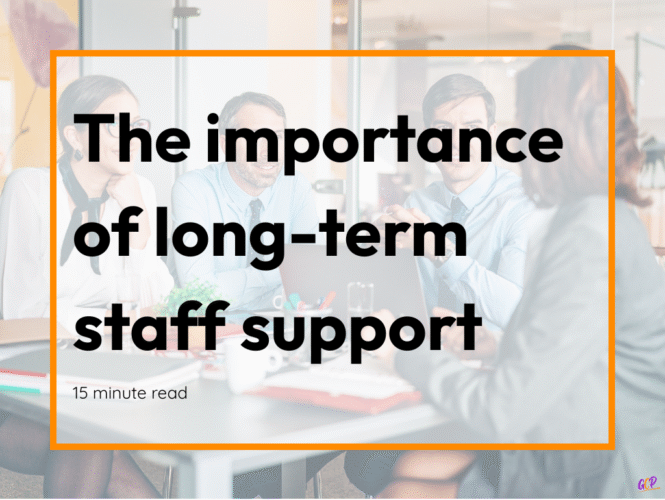Implementing change within any organisation is a delicate process, and it can be particularly challenging when it comes to gaining the support of long-term staff. These employees often have deep emotional and professional investments in the company’s existing systems, culture, and processes. Resistance to change can be especially strong among them, as they may view change as a threat to the stability they’ve known for years. However, engaging long-term staff and securing their support is crucial to the success of any change initiative.
This article explores strategies for effectively winning over long-term employees and transforming them into advocates for change, rather than opponents.
Understanding the Concerns of Long-Term Employees
Before addressing how to win over long-term staff, it’s essential to understand why they might resist change in the first place. Their resistance typically stems from a variety of concerns:
Fear of the Unknown: Long-term employees are often accustomed to established ways of working. Change can introduce uncertainty, leading to anxiety about how the new processes, roles, or structures will affect them personally.
Loss of Status or Expertise: These employees have likely built a strong sense of competence and expertise over time. A new system or process could undermine their mastery, leading them to fear a loss of influence or relevance.
Comfort with the Status Quo: After years of doing things a certain way, long-term employees might be comfortable with existing routines. Change may represent disruption, which they may view as unnecessary or even harmful.
Mistrust of Leadership Intentions: Long-term employees have often experienced multiple leadership teams and shifting organisational priorities. If past change efforts have been unsuccessful or mishandled, they may be uncertain about the new initiative and question whether leadership has their best interests at heart.
Involve Them Early in the Process
One of the most effective ways to win over long-term staff is to involve them early in the change process. By including them in discussions, planning, and decision-making, you give them a sense of ownership over the change, rather than making them feel like passive recipients. This helps minimise resistance, as they are more likely to support initiatives they have helped shape.
When long-term employees feel heard and valued, they are more likely to advocate for change rather than resist it. Use their expertise to help identify potential challenges and co-create solutions.
Communicate Transparently and Frequently
Clear and transparent communication is vital in building trust, particularly with long-term staff who may be more sceptical of change efforts. Be open about the reasons for the change, how it will impact the organisation, and what it will mean for individual employees. Address their concerns directly and honestly, even when the news isn’t entirely positive.
Regular updates and consistent communication channels can help alleviate anxiety. Encourage questions, feedback, and dialogue. By fostering an open environment, you signal to long-term employees that their opinions matter and that they’re part of the process, not just subject to it.
Emphasise the Benefits of the Change for Them
Long-term staff will be more likely to support change if they can clearly see how it benefits them. For example, if the change initiative involves new technologies, demonstrate how these tools can make their jobs easier, reduce workloads, or open up new career development opportunities.
Frame the change in terms of how it can enhance their expertise rather than diminish it. For instance, highlight how learning new skills can make them more valuable within the company or more competitive in the job market. Personalising the benefits helps to reduce the fear of loss that often accompanies change.
Respect Their Experience and Acknowledge Contributions
Long-term employees have a wealth of experience and institutional knowledge. Rather than seeing them as potential roadblocks, view them as valuable assets who can offer critical insights into how the organisation functions. Recognise and respect their contributions over the years, and reassure them that their experience will continue to be relevant, even in the new environment.
Celebrating their past achievements while framing the change as a way to build on their legacy can help foster goodwill. Publicly acknowledging their contributions also reinforces their value to the organisation, making them more inclined to support future initiatives.
Provide Training and Support
Offering comprehensive training and support is essential when introducing new processes, technologies, or systems. Long-term staff may fear that they won’t be able to keep up with the changes, especially if they feel less tech-savvy or adaptable than newer employees.
Providing training tailored to different skill levels, along with ongoing support, will help reduce anxiety and increase confidence. Let them know they won’t be left behind and that the organisation is committed to helping them succeed throughout the transition.
Leverage Their Influence as Change Champions
Long-term employees are often seen as informal leaders within an organisation due to their experience, tenure, and relationships with colleagues. If you can win over these influential individuals, they can serve as powerful advocates for change. When other employees see respected, long-standing colleagues embracing the change, they are more likely to follow suit.
To turn long-term employees into change champions, empower them with the knowledge and resources they need to confidently support the initiative. Encourage them to share their positive experiences with the change and lead by example.
Address Emotional Concerns, Not Just Practical Ones
Change isn’t just a logistical or procedural shift; it often involves a significant emotional journey. For long-term staff, this emotional component can be particularly pronounced. They may feel a sense of loss, not just in terms of routine or process, but also in terms of organisational identity or personal relevance.
Leaders need to acknowledge these emotional responses and provide support beyond the technical aspects of change. Empathy, understanding, and patience go a long way in helping employees navigate the emotional challenges of change.
Provide Opportunities for Feedback and Adjustment
Creating a continuous feedback loop is vital to ensuring that long-term employees feel engaged throughout the change process. Offer opportunities for them to share their thoughts and concerns as the initiative unfolds, and be open to making adjustments based on their feedback. This will show that leadership is responsive and flexible, which can foster a sense of trust and cooperation.
When employees see that their input can influence the outcome of the change, they feel more invested in its success. This collaborative approach can turn even sceptical long-term employees into active participants in the transformation.
Conclusion
Winning over long-term staff during a change initiative requires a thoughtful, empathetic, and strategic approach. By involving them early, communicating transparently, and respecting their expertise, leaders can reduce resistance and build trust. Providing support, training, and clear benefits will help alleviate the fear of the unknown, while acknowledging their emotional journey is key to keeping them engaged. When approached correctly, long-term employees can become strong allies in ensuring the success of change, leveraging their experience and influence to guide the organisation forward with ongoing long-term staff support.





